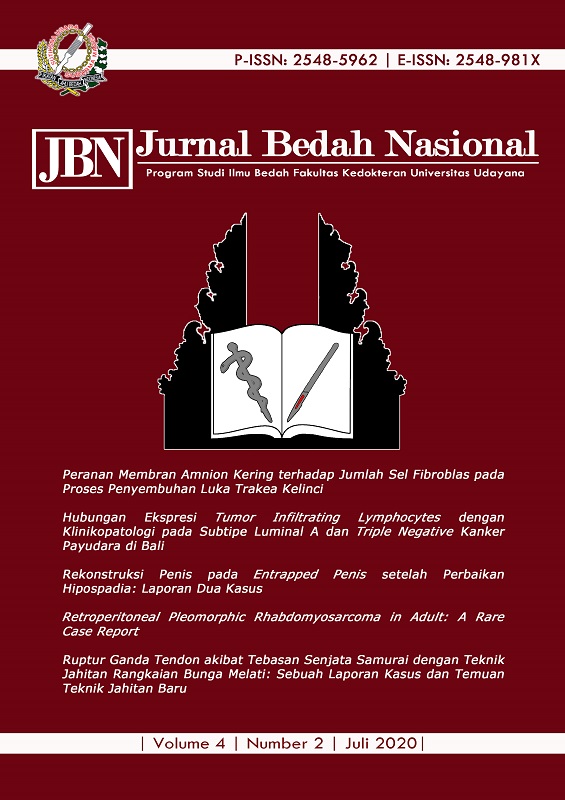Hubungan Ekspresi Tumor Infiltrating Lymphocytes dengan Klinikopatologi pada Subtipe Luminal A dan Triple Negative Kanker Payudara di Bali
Abstract
Tujuan: Untuk membuktikan adanya hubungan ekspresi TIL dengan klinikopatologi pada subtipe luminal A dan subtipe TNBC beserta ada tidaknya perbedaan antara kedua subjek tersebut. Metode: Penelitian ini merupakan penelitian observasional, dirancang secara potong-lintang di RSUP Sanglah Denpasar. Kriteria inklusi adalah penderita kanker payudara subtipe luminal A dan subtipe TNBC (triple negative breast cancer) sebagai subjek penelitian. Hasil: Pada penelitian ini terdapat 31 subjek dengan Luminal A dan 40 subyek dengan TNBC. Penelitian ini didapatkan hubungan signifikan antara stadium dengan kadar TIL pada kanker payudara subtipe TNBC (p=0,01). Pada kanker payudara subtipe TNBC stadium tinggi, kemungkinan TIL tinggi 3 kali dibandingkan dengan subjek dengan stadium I-II. Adanya hubungan yang bermakna pada penderita dengan TIL tinggi dengan stadium lanjut pada subtype TNBC dan luminal A (p=0,028; PR 1,8; 95%CI 0,54-5,9). Simpulan: Tidak terdapat hubungan signifikan yang diperoleh antara TIL dengan ukuran tumor, stadium klinis, grade histopatologi pada kanker payudara subtipe luminal A maupun TNBC. Tidak terdapat pula hubungan ukuran tumor dan grading tumor antara kanker payudara dengan subtipe TNBC dan luminal A yang memiliki TIL yang tinggi, tetapi terdapat perbedaan pada stadium tumor.
Downloads
References
2. International Agency for Research on Cancer (IARC). Cancer Fact Sheets: Breast Cancer, Estimated Incidence, Mortality, And Prevalence Worldwide In 2012. World Health Organization [serial online] 2016 [diakses 26 Agustus 2019]. Diunduh dari: https://gco.iarc.fr/today/data/pdf/fact-sheets/cancers/cancer-fact-sheets-15.pdf.
3. Kimman M, Norman R, Jan S, dkk. The Burden of Cancer in Member Countries of the Association of Southeast Asian Nations (ASEAN). Asian Pac J Cancer Prev. 2012;13:411-20.
4. Primadi O, Budijanto D, Kurniasih N, dkk. Buletin Jendela Data dan Informasi Kesehatan. Jakarta: Bakti Husada Kementrian Kesehatan RI; 2015.
5. Shah D, Osipo C. Cancer stem cells and HER2 positive breast cancer: The story so far. Genes Dis. 2016;3:114-123.
6. Goldhirsch A, Wood WC, Coates AS, dkk. Strategies for subtypes—dealing with the diversity of breast cancer: highlights of the St Gallen International Expert Consensus on the Primary Therapy of Early Breast Cancer. Ann Oncol. 2011;22:1736-47.
7. Goldhirsch A, Winer EP, Coates AS, dkk. Personalizing the treatment of women with early breast cancer: highlights of the St Gallen International Expert Consensus on the Primary Therapy of Early Breast Cancer. Ann Oncol. 2013;24:2206-23.
8. Dai X, Li T, Bai Z, dkk. Breast Cancer intrinsic subtype classification, clinical use and future trends. Am J Cancer Res. 2015;5:2929-43.
9. Ladoire S, Arnould L, Apetoh L, dkk. Pathologic Complete Response to Neoadjuvant Chemotherapy of Breast Carcinoma Is Associated with the Disappearance of Tumor-Infiltrating Foxp3+ Regulatory T Cells. Clin Cancer Res. 2008;14:2413-20.
10. Hanahan D, Weinberg RA. Hallmarks of cancer: the next generation. Cell. 2011;144:646-74.
11. Loi S. Host Antitumor Immunity Plays a Role in the Survival of Patients with Newly Diagnosed Triple-Negative Breast Cancer. J Clin Oncol. 2014;32:2935-7.
12. Gingras I, Azim HA, Ignatiadis M, dkk. Immunology and Breast Cancer: Toward a New way of Understanding Breast cancer and Developing Novel Therapeutic Strategies. Clin Adv Hematol Oncol. 2015;13:372-82.
13. Salgado R, Denkert C, Demaria S, dkk. The evaluation of tumor-infiltrating lymphocytes (TILs) in breast cancer: rcommendations by an international TILs Working Group 2014. Annals Oncol. 2015;26:259-71.
14. García-Teijido P, Cabal ML, Fernández IP, dkk. Tumor-Infiltrating Lymphocytes in Triple Negative Breast Cancer: The Future of Immune Targeting. Clin Med Insights Oncol. 2016;10: 31-9.
15. Yamaguchi R, Tanaka M, Yano A, dkk. Tumor-infiltrating lymphocytes are pathologic predictors for neoadjuvant chemotherapy in with breast cancer. Hum Pathol. 2012;43:1688-94.
16. Gunawan IP. Hubungan Antara Tumor Infiltrating lymphocytes dengan Gambaran klinikopatologis pada Pasien Triple negative breast cancer di Bali (tesis). Denpasar: Universitas Udayana Denpasar; 2015.
17. Barnes TA, Amir E. HYPE or HOPE: the prognostic value of infiltrating immune cells in cancer. Br J Cancer. 2017;117:451-60.
18. Denkert C, von Minckwitz G, Darb-Esfahani S, dkk. Tumour-Infiltrating lymphocytes and prognosis in different subtypes of breast cancer: a pooled analysis of 3771 patients treated with neoadjuvant therapy. Lancet Oncology. 2018;19: 40-50.
19. Komite Penanggulangan Kanker Nasional. Panduan Penatalaksanaan Kanker Payudara. Jakarta: Kementrian Kesehatan Indonesia; 2016.
20. Ahn SG, Jeong J, Hong S, dkk. Current Issues and Clinical Evidence in Tumor-Infiltrating Lymphocytes in Breast Cancer. J Pathol Transl Med. 2015;49:355-63.
21. Oble DA, Loewe R, Yu P, dkk. Focus on TILs: prognostic significance of tumor infiltrating lymphocytes in human melanoma. Cancer Immun. 2009;9:3.
22. Ghebeh H, Barhoush E, Tulbah A, dkk. FOXP3+ Tregs and B7-H1+/PD-1+ T lymphocytes co-infiltrate the tumor tissues of high-risk breast cancer patients: Implication for immunotherapy. BMC Cancer. 2008;8:57.
23. Macchetti AH, Marana HR, Silva JS, dkk. Tumor-infiltrating CD4+ T lymphocytes in early breast cancer reflect lymph node involvement. Clinics (Sao Paulo). 2006;61:203-8.
24. Ben‐Shoshan J, Maysel‐Auslender S, Mor A, dkk. Hypoxia controls CD4+, CD25+ regulatory T-cell homeostasis via hypoxia-inducible factor-1alpha. Eur J Immunol. 2008;38:2412-8.
25. Viale G. The current state of breast cancer classification. Ann Oncol. 2012;23:x207-10.
26. Budczies J, Bockmayr M, Denkert C, dkk. Classical pathology and mutational load of breast cancer - integration of two worlds. J Pathol Clin Res. 2015;1:225-38.
27. Bianchini G, Balko JM, Mayer IA, dkk. Triple-negative breast cancer: challenges and opportunities of a heterogeneous disease. Nat Rev Clin Oncol. 2016;13:674-90.
28. Li Z, Song W, Rubinstein M, dkk. Recent updates in cancer immunotherapy: a comprehensive review and perspective of the 2018 China Cancer Immunotherapy Workshop in Beijing. J Hematol Oncol. 2018;11: 142.
29. Schumacher TN, Schreiber RD. Neoantigens in cancer immunotherapy. Science. 2015;348: 69-74.
30. Kandoth C, McLellan MD, Vandin F, dkk. Mutational landscape and significance across 12 major cancer types. Nature. 2013;502: 333-9.
31. Gatalica Z, Snyder C, Maney T, dkk. Programmed Cell Death 1 (PD-1) and Its Ligand (PD-L1) in Common Cancers and Their Correlation with Molecular Cancer Type. Cancer Epidemiol Biomarkers Prev. 2014;23: 2965-70.

This work is licensed under a Creative Commons Attribution 4.0 International License.
Program Studi Ilmu Bedah Fakultas Kedokteran Universitas Udayana. 
This work is licensed under a Creative Commons Attribution 4.0 International License.






